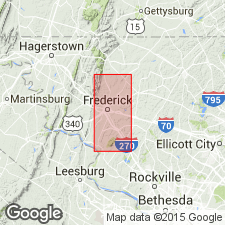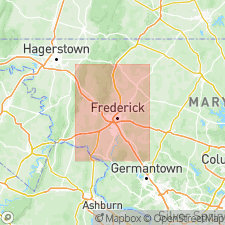
- Usage in publication:
-
- Rocky Springs Station Member
- Modifications:
-
- Named
- Dominant lithology:
-
- Shale
- Phyllite
- Dolomite
- Limestone
- AAPG geologic province:
-
- Piedmont-Blue Ridge province
Summary:
Named as lowest member of Frederick Formation (new). Named for Rocky Springs Station, just north of Fort Detrick, Frederick Co., north-central MD. Outcrops on eastern and western margins of Frederick Valley. Poorly exposed and finer grained along eastern margin. Lithology varies vertically. Lowermost rocks consist of calcareous shale and phyllite overlain by granular dolomite (laminated and argillaceous on east side of valley), of variable thickness. Lower half of member is composed of thin flaggy limestone. Upper half is dominated by thick sequence of detrital limestone. Slate belt included on east side of valley. Lower contact not exposed, but believed to be conformable with underlying Araby Formation (new). Stratigraphically overlain by Adamstown Member (new). Differs from Adamstown by absence of quartz sand in Adamstown Large portions are overlain by Triassic sediments or Quaternary mountain wash along western side of valley. A window in Triassic rocks exposes a large patch of the member just northwest of Lewistown, MD. Age is Late Cambrian (Dresbachian) based on trilobites. Report includes geologic map and sections, geologic columns, measured sections, correlation charts, and fossil lists.
Source: GNU records (USGS DDS-6; Reston GNULEX).

- Usage in publication:
-
- Rocky Springs Station Member
- Modifications:
-
- Revised
- AAPG geologic province:
-
- Piedmont-Blue Ridge province
Summary:
Pg. 14-17. Rocky Springs Station Member of Frederick Formation. Revised to exclude basal 300+/- feet (transferred to newly named Monocacy Member); top of member stratigraphically extended to include 300+/- feet of polymictic breccia (previously included in overlying Adamstown Member). As revised, consists of dark-gray, very thinly bedded, lime mudstone interbedded and interlaminated with black, calcareous shale; contains beds, 30 to 50 feet (10 to 15 m) thick, of polymictic breccia. Fossils. Trilobites from the lower part are tentatively assigned to the DUNDERBERGIA zone; see Franco Rasetti, 1961, Jour. Paleo, v. 35, no. 1, p. 104-124. A collection from the upper part of the member yielded KEITHIA SCHUCHERTI fauna; see J.F. Taylor and others, 1996, Maryland Geol. Survey Spec. Pub. no. 3, p. 142 (fig. 1) and references therein. Age is Late Cambrian [Furongian; Millardan; Steptoean to Sunwaptan].
Source: Publication.
For more information, please contact Nancy Stamm, Geologic Names Committee Secretary.
Asterisk (*) indicates published by U.S. Geological Survey authors.
"No current usage" (†) implies that a name has been abandoned or has fallen into disuse. Former usage and, if known, replacement name given in parentheses ( ).
Slash (/) indicates name conflicts with nomenclatural guidelines (CSN, 1933; ACSN, 1961, 1970; NACSN, 1983, 2005, 2021). May be explained within brackets ([ ]).

